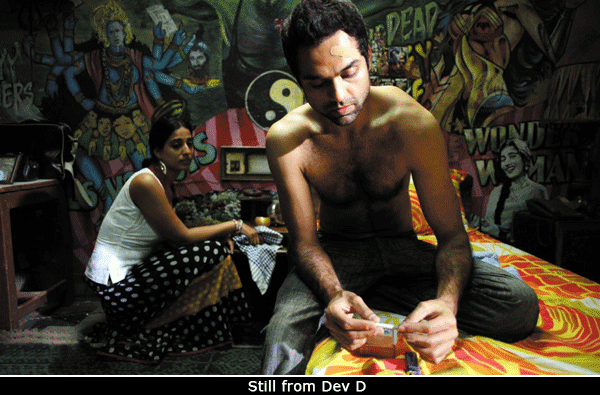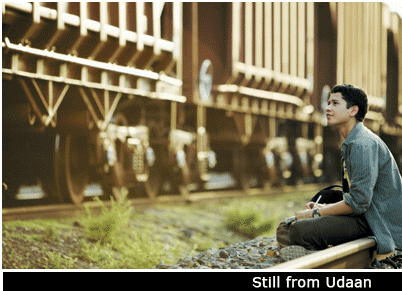- Prelude
- Guest Editor’s Column
- Hard Talk
- Eloquence of Silence
- The Age of Revivals: Gothic Revival Furniture
- Inkwell
- New Media : Living up to the chivalric code
- Universalizing Art through Individual Langue
- Speaking New Discourses
- Video Art of India- Gigi Scaria and his Videos
- Contemporary Trends of Sculpting
- In the News
- Artist Index and Statistics
- Market Insight
- Auction Reports
- The month that was
- Art Bengaluru
- Mumbai Artsighting
- Musings from Chennai
- Deccan Odyssey
- Delhi Dias
- In between – from Vadodara
- North-East Opsis
- A Tryst with Art in Madhya Pradesh
- Tradition and Beyond
- Reverie
- Indian (Sub) Way
- Creative Impulse
- Different hues of Aakriti
ART news & views
Eloquence of Silence
Volume: 2 Issue No: 8 Month: 9 Year: 2010
Language of Cinema and not language in Cinema

Every country has its cinema which speaks its own language; the country's. By language one does not mean the tongue but something that is quintessentially its own. Indian mainstream cinema represents a larger-than-life kind of scenario. Very much like our festivities. Huge idols, large cut-outs of politician and humungous garlands; the colour the noise and the chaos, one just cannot seem to have enough of it.
Hindi Cinema evolved from Parsi theatre and incorporated dollops of Jatra. Yes, it vindicates the stand that Indian cinema has had its antecedents in theatre. The language of cinema, therefore, emanates from a more western notion that cinema is more a visual art than a performing one. It conveys emotion but not always is that to be conveyed by the actor; an inanimate object or nature can do just as well.
Cinema has its own language and grammar which is now universally accepted in the post colonial and modern times. World cinema stretches from Mexico to Iran to Korea.
One can play around with form or structure but cinema speaks a certain language which overplays the visual imageries and underplays the spoken word. Rather it seeks to depict more than it conveys through words.  I am really talking about the absence of words which heightens its sensuality. Even Hollywood with all its techni-colour pictorial bluster is all about visual imagery that touches emotions more than it creates a spectacular palette. At the end of it the spoken language is important but often, immaterial in the entire scheme of things.
I am really talking about the absence of words which heightens its sensuality. Even Hollywood with all its techni-colour pictorial bluster is all about visual imagery that touches emotions more than it creates a spectacular palette. At the end of it the spoken language is important but often, immaterial in the entire scheme of things.
In the blockbuster Gone With the Wind in which Scarlett O' Hara scoops up earth in her war-ravaged southern town and says, “As God is my witness, I'll never be hungry again. “Just before the curtains came down before the interval, it encapsulated the plight of this self-willed spoilt girl who literally bites the dust! We also remember the wilful toss of curls or even the disapproving look of mammy at seeing a widowed heroine meeting Rhett Butler alone in the parlour.
In mainstream Indian films we are taken through a blow by blow account of what is happening on the screen. Well, almost! A dead body often shown up close almost always depicts death. Not an empty bed or chair. But things are changing in this cinematic space and for once, trends are toward when less is more.
The latest offering of new-age Hindi cinema is Vikram Motwane directed Udaan, the film fresh from its Cannes debut speaks the language of pure cinema. It piques our imagination and conveys so much more than it cares to say. It allows us to fill in those blanks. It is the sheer art of story telling without the wordiness. A film must have dialogues but mouthfuls of these get lost in the torrent of what is considered too cerebral and verbose. But Udaan beautifully captures the underlying tension of the young teenage boy who is somewhat forced to become a juvenile delinquent due to a tough tyrannical father.
The trends are a changing. One cannot pinpoint exactly where this started but Anurag Kashyaps' Dev D could well be the starting point. It does not need much of a spectacle like Sanjay Bhansali's version to prove the slut Devdas really is! A slew of other films like Manorama 6 feet Under, Road the Movie are the new crop of Bollywood mainline offerings which are helping to change our mindset and bringing in a new cinematic language. These are multiplex film alright but are helping to create a space among cine goers, old and young alike.
Tollywood could take a leaf out of such films to establish a new kind of film making. The potboilers apart which are ludicrous, the so called sensitive Bengali art films should also come out of this theatre drama mode; where the characters are always exercising their vocal chords. It is our cinema and it reflects our sensibilities but when we look back at Ray's Apu's Trilogy and Charulata, we see that proper grammar of cinema, which was unfortunately, later turned on its head by the director himself, when ill health forced him to shoot indoors. So we had more of the chamber drama films like Agantuk towards the end of his great filmmaking career, which did not match up to his earlier gems that captured some stunning visual images even with limited resources and means. The words made a whole lot of sense but cinema is simply not simply about words. It is not the printed word. It is cinema. Therefore, Aparna Sen's Japanese Wife touched a chord somewhere.
Bengalis love adda but that does not mean a film has to be a long-drawn adda session in which a director like Rituparno Ghosh plays the chat host; where questions are often raised and answered by the host himself, making the film extremely verbose. Only Dosar tried to break some ground even if the story was not an original one and there was too much of repetitive poetry spewed in between.
The present crop of filmmakers whether in Mumbai or Kolkata could well adhere to this grammar of cinematic beauty without harking upon the past masters. By merely paying a tribute to the masters is not all, what one learns from them and takes forward, matters more and would win entries into Oscar nominations under the foreign film tag. We are not Hollywood and just as well but when one sees the films like Amelie (French) and Welcome to Sarajevo, we know why they work and not Lagaan under the foreign films category.
The Anurag Kashyaps and Vishal Bhardwajes have started a trend of sorts. In Bengal we do find glimpses of some mastery in Suman Mukhopadhya's Mahanagar @ Calcutta while his Herbert was one of the finest films to emerge in the city in a long time. Avik Mukherjee's Ekti Tarar Khoje sadly failed to live up to the promise, simply because there were too much of advertorial interferences.
Watching Bengali films one is compelled to re-live the experience of watching a stage show. It is the jatra of the serials and soaps which are churned out with as much regularity as quick screenplays that are all sound and fury signifying nothing!
Cinema is not always about those long pauses but absence of words can say so much more. Silence speaks in many ways.
Manjira Majumdar